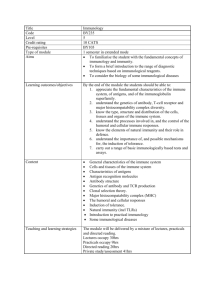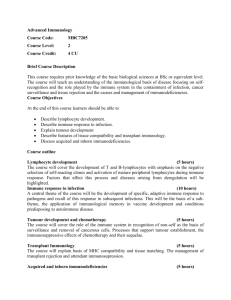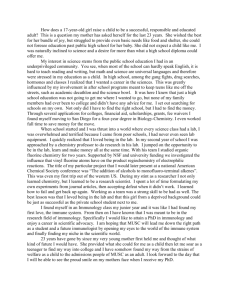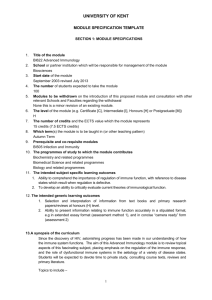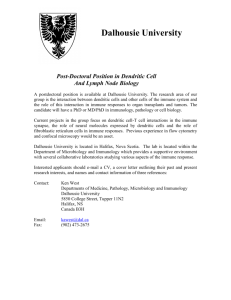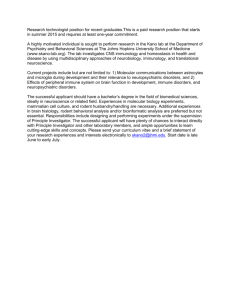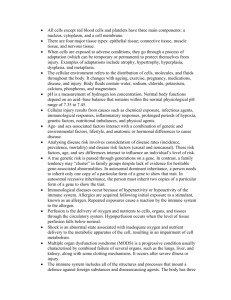B cell Modeling of Cell Communication and Signal Transduction
advertisement
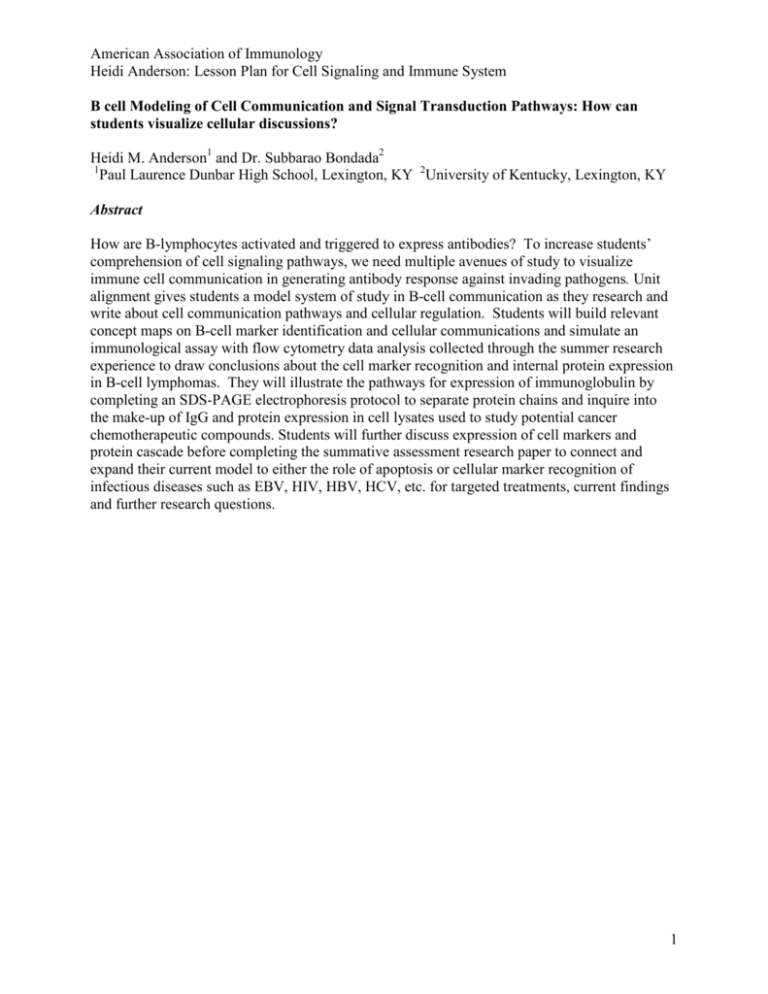
American Association of Immunology Heidi Anderson: Lesson Plan for Cell Signaling and Immune System B cell Modeling of Cell Communication and Signal Transduction Pathways: How can students visualize cellular discussions? Heidi M. Anderson1 and Dr. Subbarao Bondada2 1 Paul Laurence Dunbar High School, Lexington, KY 2University of Kentucky, Lexington, KY Abstract How are B-lymphocytes activated and triggered to express antibodies? To increase students’ comprehension of cell signaling pathways, we need multiple avenues of study to visualize immune cell communication in generating antibody response against invading pathogens. Unit alignment gives students a model system of study in B-cell communication as they research and write about cell communication pathways and cellular regulation. Students will build relevant concept maps on B-cell marker identification and cellular communications and simulate an immunological assay with flow cytometry data analysis collected through the summer research experience to draw conclusions about the cell marker recognition and internal protein expression in B-cell lymphomas. They will illustrate the pathways for expression of immunoglobulin by completing an SDS-PAGE electrophoresis protocol to separate protein chains and inquire into the make-up of IgG and protein expression in cell lysates used to study potential cancer chemotherapeutic compounds. Students will further discuss expression of cell markers and protein cascade before completing the summative assessment research paper to connect and expand their current model to either the role of apoptosis or cellular marker recognition of infectious diseases such as EBV, HIV, HBV, HCV, etc. for targeted treatments, current findings and further research questions. 1 American Association of Immunology Heidi Anderson: Lesson Plan for Cell Signaling and Immune System Table of Contents Abstract……………………………………………..… 1 Table of Contents…………………………………..…..2 Overview, Background & Learning Objectives ……..….3 Unit Alignment Day1-2…………..…………………..………..………..5 Day3-5………………………………………..………..6 Day6 Summative…………………………………..…...7 Unit Supplemental Assay Calculations & Key................8 Unit Supplemental Flow Cytometry Activity……….….10 Unit Supplemental SDS-PAGE Procedures ….............13 Bibliography…………………………………………..14 2 American Association of Immunology Heidi Anderson: Lesson Plan for Cell Signaling and Immune System B cell Modeling of Cell Communication and Signal Transduction Pathways: How can students visualize cellular discussions? Heidi M. Anderson and Dr. Subbarao Bondada I. Overview: Students will cover concepts of cell communication while using the immunological system as a model. Activities and laboratory experiences will be completed to address the goals of visualizing cellular discussions as in immunological cell lineages. The material best fits within a cellular biology larger unit of study or as a subset of biotechnology application. II. Science Backgrounds Content knowledge can be covered through extra reading as attached, which students will complete throughout the unit. III. Student Outcomes Students will complete activities, lectures, and discussions on general cellular communication and signal transduction pathways as well as specific model receptors and pathways in immunological cellular processes. IV. Learning Objectives & Curriculum Standards: AP Biology Enduring Understanding 3.D: Cells communicate by generating, transmitting, and receiving chemical signals. Students will learn mathematical skills that apply to the fields of immunology and biotechnology while completing SDS-PAGE and analyzing data collected from flow cytometry and Western-blot. 3.D.1: Cell communication processes share common features that reflect a shared evolutionary history. 3.D.2: Cells communicate with each other through direct contact with other cells or from a distance via chemical signaling. 3.D.3: Signal transduction pathways link signal reception with cellular response. 3.D.4: Changes in signal transduction pathways can alter cellular response. 4.B.2: Interactions between cells affect the fitness of the organism. 4.C.1: Variation in molecular units provides cells with a wider range of functions. Science Practices 1-7: Students can use representations and models to communicate scientific phenomena and solve scientific problems; can use mathematics appropriately; can engage in scientific questioning to extend thinking or guide investigations; can plan and implement data collection strategies appropriate to a particular scientific question; can perform data analysis and evaluation of evidence; can work with scientific explanations and theories; can connect and relate knowledge across various scales, concepts, and representations in and across domains. 3 American Association of Immunology Heidi Anderson: Lesson Plan for Cell Signaling and Immune System KY Core Academic Standards & Expectations: 2.3 Students identify and analyze systems and the ways their components work together or affect each other. 2.1 Students understand scientific ways of thinking and working and use those methods to solve real-life problems. KY Enduring Understandings: Students will understand that: *the many body cells in an individual can be very different from one another even though they are all descended from a single cell and thus have essentially identical genetic instructions. Different parts of the instructions are used in different types of cells. *identify a variety of specialized cell types and describe how these differentiated cells contribute to the function of an individual organism as a whole *describe and classify a variety of chemical reactions required for cell functions *describe the processes by which cells maintain their internal environments within acceptable limits Skills & Concepts: Students will: *identify and investigate areas of current research/innovation in biological science. Make inferences/predictions of the effects of this research on society and/or the environment and support or defend these predictions with scientific data * describe how science and technology interact. Research and investigate the impact of technology on society and how technological advances have driven scientific research http://education.ky.gov/curriculum/docs/Documents/POS%20with%20CCS%20for%20public%2 0review.pdf p.509 http://education.ky.gov/curriculum/sci/Pages/Curriculum-Documents-for-Science.aspx V. Time Requirements Time allotments in lesson are for 90 minutes blocks meeting every other day. 4 American Association of Immunology Heidi Anderson: Lesson Plan for Cell Signaling and Immune System Unit Alignment Day1: Students will review prior knowledge and build connections to cell communication. Review prior knowledge/vocabulary and concepts: Biochemistry, macromolecules, glycoprotein &integral membrane proteins, phosphorylation, mitosis & cyclin/CdK, cell proliferation, gene expression acetylation/methylation, transcription/translation, mutations, phagocytosis Pre-Test over cell communication & immune system Overview & discussion: Cell Communication & Signal Transduction Pathways Day2: Students will read text on the immune system as a model of cell communication and discuss mechanisms by which these cells and chemical signals are used in innate and adaptive immunity. Reading Activity: Bondada, S., Chelvarajan, R. & M. Gururajan, 2005. “B Lymphocytes” Encyclopedia of Life Science, John Wiley & Sons, Ltd. Introduction: WBC classification with Innate vs. Adaptive Immunity, Cellular vs. Humoral Immunity Compare/Contrast Lecture: Innate vs. Adaptive (Cellular vs. Humoral) Immunity Activity A: Concept Mapping Cellular Interactions, with cytokines and cell receptor identifications New Terminology: Cells Markers/Receptors Protein Cascade Leukocytes CD19 BID Neutrophils CD4+ BCL XL Eosinophils CD8+ BCL-2 Basophils CD3 TCL Macrophages BCR PAR-4 Mast cells TCR BKT Dendritic cells MHC I cIAP2 T cells (Th1, MHCII Th2, CTL or Tc, Treg) B cells (Plasma, Memory) NK cells Lymphocytes Cytokines/ Chemokines IL-1 IL-2 IL-4 IL-5 TNF-β γ−IFN Immunoglobulins IgM IgG IgE IgA IgD Opsonization 5 American Association of Immunology Heidi Anderson: Lesson Plan for Cell Signaling and Immune System Day 3: Students will read and discuss MHC and the means by which our immune system tells self from non-self as well as complete lab activities to learn how to collect evidence and analyze data for immunological studies. Reading: Gregory, E. 2005 “An Introduction to the Major Histocompatibility Complex” Marieb, E. & K. Hoehn, 2007. Human Anatomy & Physiology:“Too clean for our own good?” p.824 Writing: Students will form a concept map on MHC classification and diagram relationships between cellular and marker vocabulary from article. Students will make connections between cell lineages and the role each cell plays and how scientists can identify differences through cell markers. Students will then use the concept map to write a short summary of the article and the implications of MHC. Lab Activity B: Cell Counting and Density Calculations Worksheet 1. Ward’s Catalog WBC Counts as a Diagnostic Tool Lab Kit 36W0049 2. Assay Trials Calculations Worksheet for determining solution concentrations in trials Lab Activity C part 1: Drug Treatment Assay Flow Cytometry Data Analysis for presence of T cell, B cell and Macrophage Activity Activity B: Concept Map additions: Immune System Overview Concept Map: Supplement: “Response to Antigen Invasion” as found in Marieb, E.N. & K. Hoehn. 2007. Human Anatomy & Physiology Study Guide, 7th ed. Pearson Publishing p.591. *Disease Research Activity: Students will research specific disease impacting different immunological cell lines: Students research one for homework and share in class the main pattern of infection and present findings in a short 2-3 minute informal presentation: Potential Pathogen/Host Cell interaction Diseases: HIV, EBV, HBV, HCV, Toxic Shock… Potential Autoimmune Diseases: Lupus, Arthritis, Grave’s, Thrombocytopenia, Asthma… Day4: Students will model cellular interactions and communication within immune system. Activity: Play-doh modeling of cells and interactions from readings -Make stop action claymation or cartoon videos of the cellular and cytokine cascades after normal antigen presentation to immune cellsDiscussion: Cell Signal Cascades in B cell pro- & anti-apoptosis proteins: BID, BCL-xl, BCL-2. Pro- & anti-apoptotic signal pathways are important in the mitochondrial membrane for cellular regulation or energy regulation in cells and change then during apoptosis so measuring levels can determine the impact of chemotherapy treatments on cell populations. Lab Activity C part 2: How does compound 1919x affect pro- and anti-apoptotic protein cascades? Using Collected Data for Analysis of Western-Blots 6 American Association of Immunology Heidi Anderson: Lesson Plan for Cell Signaling and Immune System Day5: Students will complete an SDS-PAGE lab while analyzing data for protein expression. Discussion & Diagramming Activity: Immunoglobulin classification, expression from B-cells and protein make-up with five subclasses of antibodies: Immunoglobulin A (IgA), high concentrations in the mucous membranes lining the respiratory passages and gastrointestinal tract, saliva and tears. Immunoglobulin G (IgG), the most abundant antibody protects against bacterial and viral infections. Immunoglobulin M (IgM), found in the blood and lymph fluid, first made to fight a new infection. Immunoglobulin E (IgE), associated with parasitic diseases and with allergic reactions, found in the lungs, skin, and mucous membranes. Immunoglobulin D (IgD), exists in the blood in small amounts and is the least understood antibody. http://kidshealth.org/parent/system/medical/test_immunoglobulins.html http://pathmicro.med.sc.edu/mayer/igstruct2000.htm Pre-lab Analysis of Western-blot films Lab Activity D: SDS-PAGE Electrophoresis Protocols for IgG Separation and Molecular Weight measures Day6: Final Summative Assessment: Essential Question: How do cells communicate by generating, transmitting, and receiving chemical signals? What is the role of apoptosis in immune system? How are pathogens able to attack immune cells? Task: After researching primary and secondary literature on cell communication, immune response, and apoptosis in immunity, students will write an essay/research paper that explains the role of programmed cell death (apoptosis) in living organisms, pathogen host cell recognition for diseases of immune cells, or a specific autoimmune disorder of their choosing. What conclusions or implications can you draw from literature search? Cite at least 5 sources, pointing out key elements from each source and addressing the credibility and origin of sources. Identify gaps and unanswered questions in the research. 7 American Association of Immunology Heidi Anderson: Lesson Plan for Cell Signaling and Immune System Supplemental Resources for Unit: Calculations for Assay Trials on B-cell Populations Lab Supplement Activity B Directions: Complete the following calculations for a drug trial using the equation C1V1= C2V2 1. The cell concentration we start with is 6.3 x106 cells/mL from our cell counts taken using a hematocytometer. We wish to have a final concentration of cells equal to 0.5x106 cells/mL in 1000µL. What volume of the original cell concentration will we need to add to media to make a final volume of 1000µL? C1 = V1= C2 = V2= 2. In 1919x Trial #1, we will dilute a 5mM concentration of treatment drug 1919x stock solution to a 0.1mM concentration of 100µL. What is the volume of old stock that we use to dilute to a new concentration of 0.10mM drug 1919x concentration with final volume of 100µL? C1 = V1= C2 = V2= 3. In 1919x trial #1, we need to further dilute the New 0.1mM drug stock to a 0.3µM concentration with a total volume of 1000uL. What volume of the new stock should we use to make a 0.3µM solution? C1 = V1= C2 = V2= 4. The control treatment for 1919x trial #1 will include LPS (lipopolysaccharide) in an original concentration of 5000µg/mL diluted to 5µg/mL concentration in 1000µL. Df(dilution fold)=5 C1 = V1= C2 = V2= 8 American Association of Immunology Heidi Anderson: Lesson Plan for Cell Signaling and Immune System KEY Calculations for Assay Trials on B-cell Populations Lab Supplement Activity B Directions: Complete the following calculations for a drug trial using the equation C1V1= C2V2 1. The cell concentration we start with is 6.3 x106 cells/mL from our cell counts taken using a hematocytometer. We wish to have a final concentration of cells equal to 0.5x106 cells/mL in 1000µL. What volume of the original cell concentration will we need to add to media to make a final volume of 1000µL? C1= 6.3x106 cells/mL V1= ? C2=0.5x106 cells/mL V2= 1000 µL solution V1= 80µL 2. In 1919x Trial #1, we will dilute a 5mM concentration of treatment drug 1919x stock solution to a 0.1mM concentration of 100µL. What is the volume of old stock that we use to dilute to a new concentration of 0.10mM drug 1919x concentration with final volume of 100µL? C1= 5mM V1= ? C2= 0.1mM V2=100µL solution V1=2µL 3. In 1919x trial #1, we need to further dilute the New 0.1mM drug stock to a 0.3µM concentration with a total volume of 1000uL. What volume of the new stock should we use to make a 0.3µM solution? C1= 0.1mM =100µM V1= ? C2= 0.3µM V2=1000µL solution V1=3µL 4. The control treatment for 1919x trial #1 will include LPS (lipo-polysaccharide) in an original concentration of 5000µg/mL diluted to 5µg/mL concentration in 1000µL. Df(dilution fold)=5 C1= 5000µg/mL V1= ? C2= 5µg/mL V2=1000µL solution V1= 1µL 9 American Association of Immunology Heidi Anderson: Lesson Plan for Cell Signaling and Immune System Lab Activity C Part 1. Analysis of Flow Cytometry Data Background: Flow cytometry is a laser-based technology used in cell counting and biomarker detection. Cultures of spleen cells are grown in vitro and then grown in a control or treatment group to determine the response of cells lines to treatment and finally exposed to antibodies that bond to set antigens on immunological cell lines with florescent markers for detection by lasers in the flow cytometer. *Students read further details and schematic from http://www.unsolvedmysteries.oregonstate.edu/flow_06 Objectives: Students learn how to read flow cytometry data from experimental treatments in vitro culture assays of spleen cells: Experimental Design: 1) In lanes B2, C2, D2, E2, of cell culture trays, we will use PE CD19, FITC Class II, and BiotinPECY5 IgM antibodies to fluoresce cells for identification of B-cells. Positive results in Fig.2 2) In Lanes B3, C3, D3, E3, of cell culture trays, we will use FITC CD4, PE CD8, BiotinPECY5 F4/80 antibodies to fluoresce cells for identification of T-cells. Positive results in Fig.1&3 10 American Association of Immunology Heidi Anderson: Lesson Plan for Cell Signaling and Immune System A. The data profiles are read as follows for media only controls: CD8 PE Standards: CD4 Th cells, CD19 B cells, Cytotoxic T Lymphocytes, Immunoglobulin expression CD4 FITC CD19 PE Fig. 1 positive test CD4 T-cells, lower-right quadrant Class II FITC CD8 PE Fig. 2 positive test CD19 B cells, upper-left quadrant CD4 FITC Fig.3 positive test CD8+ upper-left quadrant, CD4+ T cells lower-right quadrant 11 American Association of Immunology Heidi Anderson: Lesson Plan for Cell Signaling and Immune System Protein Separation using SDS-PAGE Lab Protocol: Activity D Objective: Students will learn the steps of protein electrophoresis and be able to analyze the products by protein molecular weights and expression. Pre-lab Activity: Analysis of Western-blots from treatments from activity B. link1, link2, link3, link 4 Background: Students have completed simple gel electrophoresis of DNA extraction prior to completing a protein analysis using SDS-PAGE to now study immunological and muscle proteins by molecular weight. Materials: 1. Ward’s Scientific Catalog Mini-protean TGX precast gels SDS Solution 10% Tris-Gly SDS Running Buffer Comparative Proteomics Kit I: Protein Profiler Protein Fixative Stain Colored PAGE Marker 2. Carolina Biological Catalog Serum Antibody Set or Fisher Scientific Catalog IgG Goat Antihuman 0855127 3. Microcentrifuge Tubes Micropipettes & Tips 10-100ul Floating Microtube rack Hot water bath 4. Sample buffer: from Bondada Lab with 2MEA 2 ml 0.5M Tris HCL (ph6.8) 2 ml 100% glycerol 0.4g SDS 2mg Bromophenol Blue 0.25 ml 2MEA 0.75 DH2O without 2MEA 2 ml 0.5M Tris HCL (ph6.8) 2 ml 100% glycerol 0.4g SDS 2mg Bromophenol Blue 0.75 DH2O Procedures: 1. Load Precast SDS-PAGE gels and 1X running buffer into apparatus (wear PPE, gloves for safety while handling gels and buffer) 2. In a microcentrifuge tube, place 10ul IgG + sample buffer without 2MEA and in second microcentrifuge tube place 10 ul IgG + sample buffer with 2MEA. Vortex vigorously. 12 American Association of Immunology Heidi Anderson: Lesson Plan for Cell Signaling and Immune System 3. Heat tubes 10 minutes in boiling water and vortex again. 4. Load wells with Colored PAGE Marker and then 2 samples of IgG preparations. Load remaining wells with samples from Protein Profiler Kit for comparative proteomics. 5. Run SDS PAGE gels for ~1 hour at 120V (35 amps) 6. Fix and Stain gels and then visualize with light table. Bibliography Bondada, S., Chelvarajan, R. & M. Gururajan, 2005. “B Lymphocytes” Encyclopedia of Life Science , John Wiley & Sons, Ltd. Gregory, E. 2005. “An Introduction to the Major Histocompatibility Complex” Marieb, E. & K. Hoehn, 2007. Human Anatomy & Physiology:“Too clean for our own good?” p.824. Marieb, E.N. & K. Hoehn. 2007. Human Anatomy & Physiology Study Guide, 7th ed. Pearson Publishing p.591. Ward’s Catalog: WBC Counts as a Diagnostic Tool Lab Kit 36W0049 13
